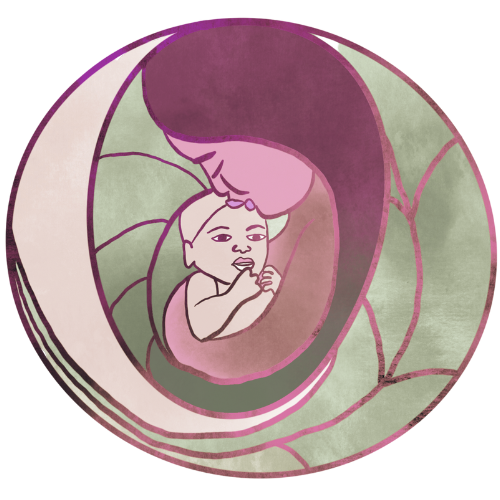Working with the Moon: How Lunar Cycles Can Support Pregnancy and Birth
Intro to Working with the Lunar Cycles During Pregnancy
For thousands of years, people have looked to the moon as a guide. Farmers planted by it, sailors navigated by it, and healers—especially midwives—watched its cycles as they tended to fertility, pregnancy, and birth. Even today, many midwives and doulas keep a quiet eye on the moon’s phases, not because it’s a precise science for predicting due dates, but because it offers a gentle, grounding rhythm during a time of great change.
Pregnancy is already a journey of ebb and flow—times of rest, bursts of energy, deep reflection, and moments of release. The moon moves through similar cycles every month, offering a beautiful natural mirror. Whether you approach it from a spiritual, symbolic, or simply mindful perspective, working with the moon can help you feel more connected to your body, your baby, and the seasons of your pregnancy.
This guide will explore the moon’s deep-rooted connection to birth, walk you through the lunar phases and their meaning, share rituals and journaling ideas for each stage, and show how midwives and doulas weave this ancient awareness into modern care.
The Moon and Birth – A Connection Through History
Before there were fertility tracking apps or prenatal charts, midwives often relied on natural signs to guide their work. One of the most constant and visible signs was the moon.
In many cultures, the moon’s ~29.5-day cycle was linked to women’s reproductive cycles, making it a natural tool for tracking fertility and pregnancy milestones. Ancient Egyptian midwives kept records of births alongside moon phases. In Europe, “granny midwives” often marked full moons as a time to prepare for a possible rush of babies.
Closer to home, in Maryland’s rural communities, farmers and healers noticed patterns between moon phases and the timing of animal births, crop planting, and even fishing. Folklore in the Chesapeake Bay region included beliefs about “full moon babies” being especially spirited or strong.
While science has found no conclusive proof that the moon triggers more births, many Maryland midwives can share stories of being busier during full moons, especially when combined with changes in barometric pressure from approaching storms. It’s less about prediction and more about honoring the moon’s rhythm as one of many subtle influences on the body.
For more on how myths and traditions shape birth care, see Midwifery Myths Debunked.
Understanding the Lunar Cycle
The moon moves through eight distinct phases, each lasting a few days. Here’s how they can be used as a gentle framework during pregnancy:
New Moon (Dark Moon) – A time of rest, quiet, and setting intentions. In pregnancy, this could be a moment to slow down, nurture yourself, and envision what you want for the next month.
Waxing Crescent – Energy starts to rise. It’s a good time to start new projects, such as signing up for a childbirth class or researching midwives and doulas.
First Quarter – A period for decision-making and commitment. In pregnancy, it might mean finalizing your birth plan or choosing your support team.
Waxing Gibbous – Refinement and preparation. This could be packing your birth bag, organizing the nursery, or adjusting your wellness routine.
Full Moon – Peak energy and illumination. Symbolic of culmination and release—this can be a time for connecting with your body’s readiness for birth.
Waning Gibbous – Gratitude and sharing. Perfect for writing thank-you notes, connecting with friends, or attending a prenatal circle.
Last Quarter – Letting go of what’s not serving you. This might mean releasing fears about birth or delegating stressful tasks.
Waning Crescent – Rest, reflection, and quiet integration. A time for deep sleep, meditation, or preparing emotionally for labor.
Doulas and midwives may not “plan” births around these phases, but they can use them as a rhythm for emotional check-ins, self-care reminders, and spiritual support throughout your pregnancy.
If you’re crafting a birth plan, see Creating a Birth Plan: Embrace Your Inner Wisdom for ideas on weaving in moon awareness.
Practical Ways to Align Pregnancy with the Moon
Journaling
A moon + pregnancy journal lets you track both the moon’s phase and your own inner cycles.
Note the current phase and date.
Record your physical sensations, cravings, dreams, and emotions.
Look for patterns over time—do you feel more tired during waning phases? More creative during waxing phases?
Rituals
These can be as simple as lighting a candle or as involved as a guided meditation.
New Moon: Brew a pregnancy-safe herbal tea like chamomile or lemon balm, then set intentions for the month ahead.
Full Moon: Spend time outside under the moonlight, placing a hand on your belly, and visualizing the safe arrival of your baby.
Waning Moon: Write down fears or stresses, then tear up the paper as a symbolic release.
The American Herbalists Guild – Pregnancy-Safe Herbs is a great resource if you want to add gentle plant allies to your rituals.
Working with Midwives and Doulas
Some midwives and doulas integrate moon cycles into prenatal visits, using them as a natural “calendar” for discussing emotional well-being, energy levels, and birth preparation. A waning crescent visit might focus on rest, while a waxing crescent could be a time to talk about active preparation.
Moon Cycles and Timing Birth
The belief that full moons bring more babies has been around for centuries. Studies, including those in the National Library of Medicine, haven’t confirmed a strong link, but midwives in Maryland still notice “full moon weeks” when more calls come in.
Some midwives even prepare their on-call schedule more attentively during full moons, just in case. Doulas may keep an extra bag packed. Whether or not the moon truly influences labor onset, the awareness can help everyone feel more attuned and ready.
It’s also important to see moon awareness as grounding rather than predictive. Watching the moon move through its phases can be a daily reminder that change is constant and natural—and that your baby will arrive in their own perfect time.
For tips on making early labor at home more comfortable, see Laboring at Home Before the Midwife Arrives.
Creating Your Moon + Birth Journal
Step 1: Choose Your Journal
Pick something that feels special to you—a handbound leather notebook, a linen-covered journal, or even a digital app you enjoy using.
Step 2: Track Moon Phases
Use the NASA Moon Phases Calendar to mark each phase.
Step 3: Pair Pregnancy Notes with the Moon
Log moods, dreams, cravings, and physical changes alongside each phase. Add reflections about rituals or activities you tried.
Step 4: Review with Your Support Team
Sharing your notes with your midwife or doula can spark helpful conversations about patterns in your pregnancy and what’s working for you.
Final Thoughts
Working with the moon during pregnancy isn’t about superstition—it’s about connection. The moon offers a steady, cyclical reminder that everything in nature has its seasons: times to plant, times to grow, times to rest, and times to release.
For expectant parents—and for the midwives and doulas who support them—aligning with lunar cycles can bring mindfulness and ritual into the birth journey. Whether you follow it closely or simply glance up now and then, the moon can be a soft anchor during one of life’s most profound transitions.
If you’re ready to explore your birth journey with the support of an experienced midwife, contact us today.
FAQs
1. Do more people really go into labor during the full moon?
While scientific studies, including those published in the National Library of Medicine, generally find no statistically significant spike in births during full moons, the stories persist—and for good reason. Many midwives, doulas, and labor and delivery nurses report seeing more calls and births clustered around the full moon. Some connect it to subtle gravitational shifts, others to changes in barometric pressure or the psychological influence of a bright, energizing night sky. Whether or not there’s a direct cause, the full moon remains a meaningful symbol for many birth workers. Even if it doesn’t change the timing of labor, it can offer a moment for reflection, gratitude, and readiness as you approach your due date.
2. How can I track my pregnancy with moon phases?
Start by printing or bookmarking a lunar calendar, such as the NASA Moon Phases Calendar, and keeping it in a visible place. Each day, note the current moon phase and write a few lines about your physical sensations, energy levels, cravings, emotions, or dreams. Over time, you might notice patterns—perhaps you feel more active during the waxing moon or more introspective during the waning phases. You can use these patterns to schedule self-care, rest, or important tasks. Some parents even align certain prenatal rituals—like affirmations, meditation, or gentle yoga—with specific phases. Sharing your notes with your midwife or doula can open up insightful conversations about how your emotional and physical states ebb and flow throughout your pregnancy.
3. Can doulas use moon cycles in birth planning?
Yes—many doulas, especially those with a holistic approach, find value in weaving moon awareness into birth preparation. This might look like helping clients set intentions during the new moon, encouraging active preparation during the waxing phases, or creating a calming ritual around the full moon. It’s important to note that this isn’t about predicting your baby’s arrival, but rather using the moon as a guide for pacing and self-awareness during pregnancy. A doula might also plan prenatal visits around certain moon phases to check in on emotional well-being, energy, and readiness for birth. For families who find comfort in symbolism or nature’s rhythms, this can create a deeper connection to their pregnancy journey and offer a beautiful framework for mindful preparation.
4. Are moon-based rituals safe during pregnancy?
Most moon-based rituals are safe and gentle, especially if they focus on mindfulness, journaling, meditation, or non-invasive activities like lighting candles, making affirmations, or taking a moonlit walk. If your rituals involve herbs, always choose pregnancy-safe options, such as chamomile, nettle, or lemon balm, and consult with your midwife or a certified herbalist before adding them to your routine. Physical practices, like yoga or dance, should be adapted for pregnancy. Avoid anything that feels strenuous, overheats you, or causes discomfort. The key is to ensure your rituals feel nurturing, restorative, and supportive of your body’s needs. The moon’s influence is symbolic and reflective—there’s no need for extremes to align with it. Gentle, intentional practices work best during pregnancy.
5. Is this approach spiritual, scientific, or both?
It can be either—or both—depending on how you relate to it. Some families approach the moon purely from a symbolic or spiritual perspective, using it as a guide for intention-setting, emotional connection, and ritual. Others see it through a scientific lens, observing natural cycles as a way to reflect on patterns in mood, energy, or physical sensations during pregnancy. And many people blend the two approaches, honoring the moon’s symbolism while also acknowledging the lack of definitive scientific evidence linking moon phases to birth timing. The beauty of working with the moon is that it’s flexible—you can embrace it in a way that aligns with your beliefs, values, and birth vision, making it a personal and meaningful part of your pregnancy journey.

